Footwear Market Analysis: Insights to Prepare You for Next Season
Explore how brands and retailers have approached the footwear category over the past five years based on transaction data from our extensive network of clients, and discover how you can use these findings to inform your wholesale growth strategy for shoes in the coming seasons.
.png)
The Footwear Market at a Glance

The global footwear market is shifting toward accessibility, with rising demand for lower-priced styles and more comfort-driven silhouettes. Regional preferences, style trends, and economic concerns are reshaping consumer behavior and brand strategies worldwide.
Exclusive transaction data from JOOR reveals:
- Demand for accessible footwear accelerates: shoes under $250 now make up 42% of global market share
- Sneakers are still the must-have style: the category accounts for 52% of global footwear units sold in 2025
- EMEA favors luxury footwear: 41% of units sold in the region in 2025 were in the over $500 retail price bracket
Overview of the Footwear Market
Over the past several years, retailers have been investing a steadily decreasing portion of their overall budget in the footwear category, in exchange for increased investment in apparel.
Knowing that retailers are being selective and highly curated in their footwear assortments, it becomes critical for brands to understand what categories are of most interest, what price points are working, and regional differences in the footwear market.
As fashion’s leading wholesale management platform, with over 14,000 discerning brands and 675,000 curated fashion buyers across 150 countries, we’ve performed an in-depth analysis of the category and collated our insights. Read on to learn more about the footwear landscape and discover how to use our data to shape your strategy for the category in the upcoming seasons.
Growing Demand for Accessible Pricing
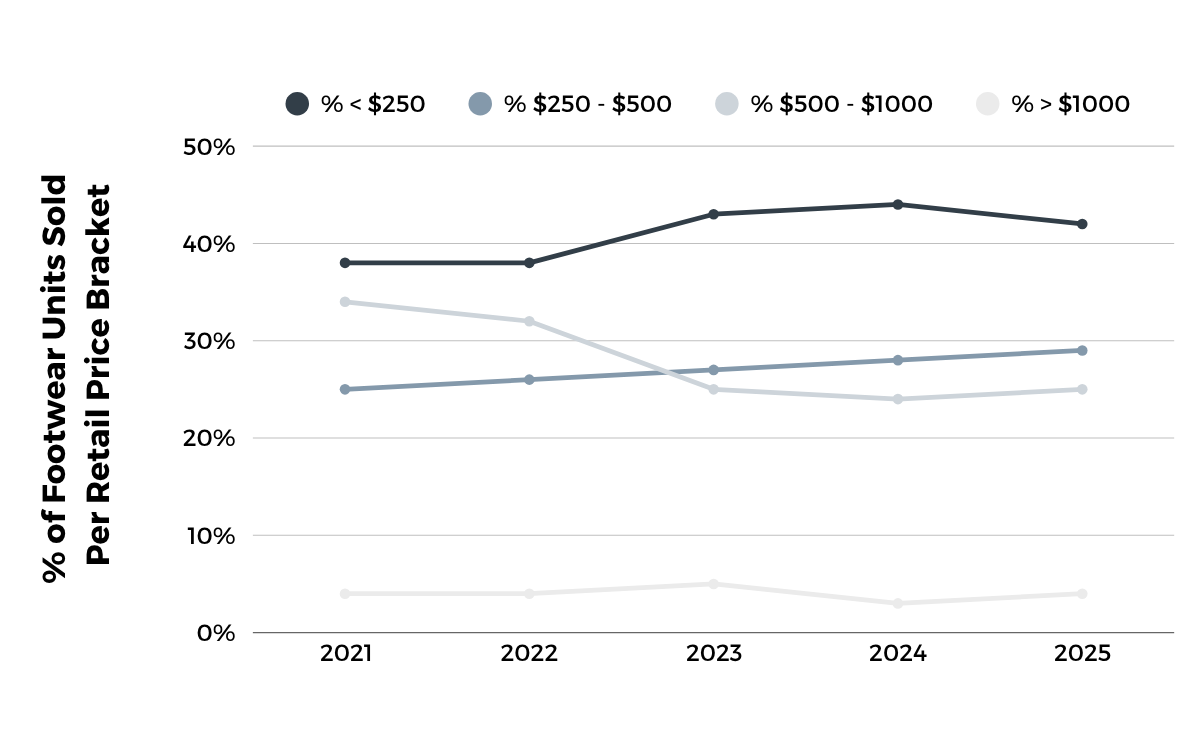
From 2021 to 2025, the portion of retailers’ footwear purchases in the $500-$1K retail price point decreased, while the portion of buys falling under $500 increased. This movement in the market has resulted in a decrease of -11% in the average footwear retail price, going from $425 in 2021 to $378 in 2025.
Economic uncertainty means consumers are spending less, and footwear appears to be an area where they are willing to reduce their discretionary purchases. It comes as little surprise that the rise of price-sensitive consumers has fueled a growing retailer demand for more accessible price points. Globally, shoes priced under $250 now account for 42% of total market share, up from 38% five years ago, signaling a clear shift toward affordability as a key purchase driver.
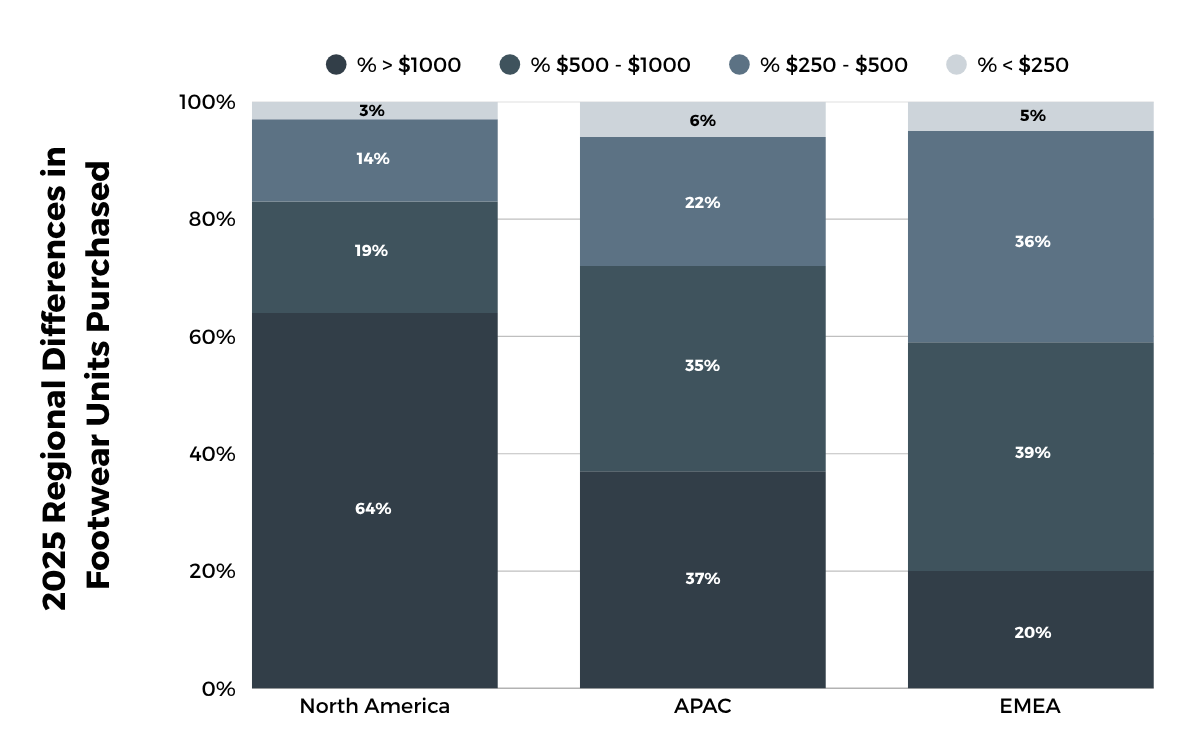
In North America, this trend is even more pronounced, with shoes under $250 representing 64% of total sales. Tariff announcements earlier in 2025 saw several major U.S. footwear brands, including Nike, indicate potential price increases—while consumers appear to be favoring more competitively-priced options, both brands and retailers are navigating a complex balance between value perception and profitability.
The shift toward affordability extends well beyond North America. In the APAC region, while the ultra luxury segment of footwear over $1,000 has remained relatively stable, footwear priced between $500 and $1,000 has dropped sharply from 43% to 22% over the last five years. Simultaneously, there has been a dramatic increase in demand for shoes under $250, with the category surging from 20% in 2021 to 37% of total market share in 2025.
The Key Takeaway for Brands
Footwear brands in the under $250 category are well-positioned for growth. Those with offerings at higher price points should remain flexible. Understand that elevated pricing poses a risk for buyers and be open to negotiating MOQs. Consider if you are in a position to introduce an entry-level shoe style to broaden appeal without diluting your brand value.
The Key Takeaway for Retailers
To add more affordable footwear options to your assortments, use JOOR Discover to explore and connect with new brands. Filter by wholesale price range to search for footwear offerings within your desired price brackets.
Sneakers Remain a Must-Have Style
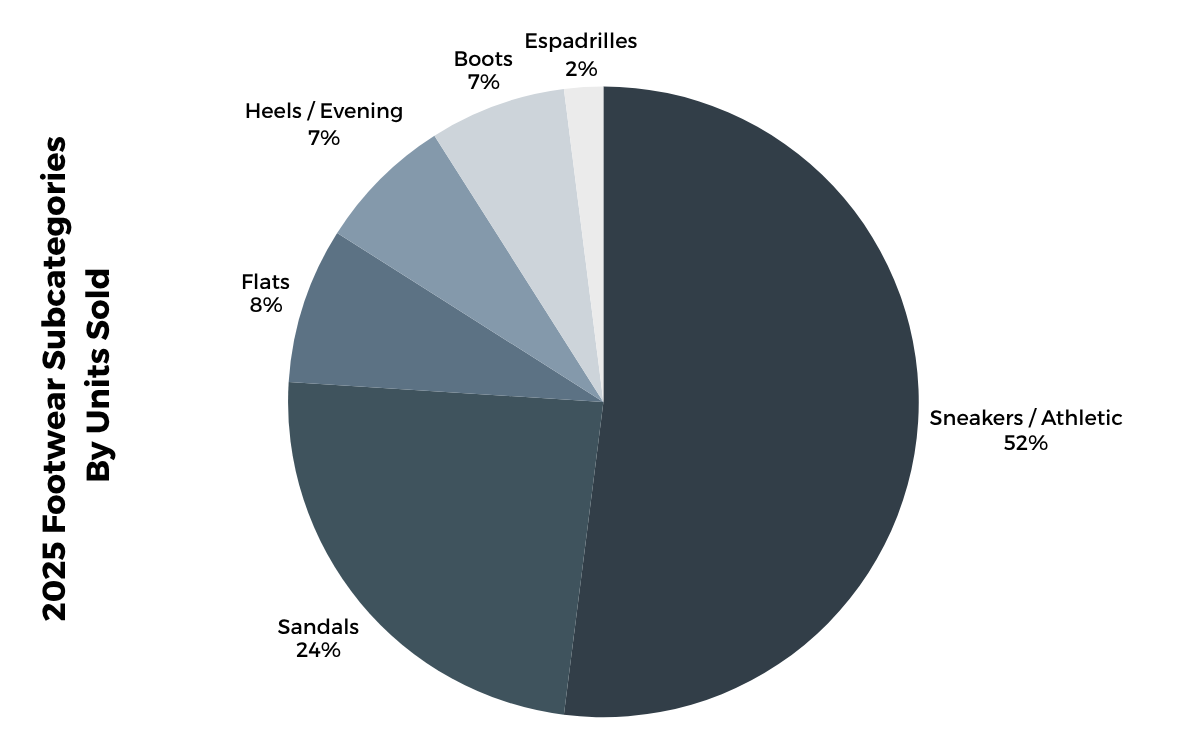
Over the past five years, sneakers have not only remained the dominant footwear category but also delivered the most pronounced growth in market share, rising from 48% in 2021 to a post-pandemic peak of 57% in 2023.
While this surge was driven largely by the global trend toward comfort and versatility, sneakers have sustained their appeal beyond that moment, holding a 52% share in 2025. Their continued strength proves just how deeply casual dressing has reshaped consumer priorities.
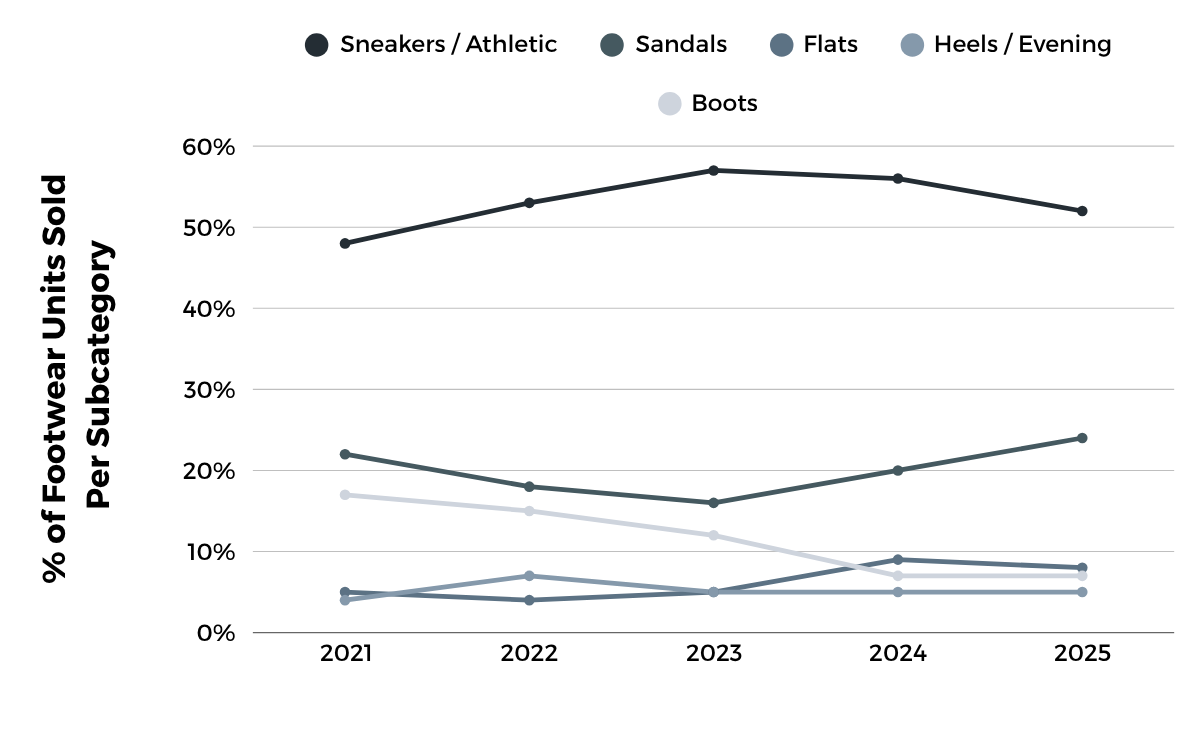
While sneakers may have reached market saturation with buyers scaling back over the past two years, this market share is being captured instead by growth in other flat styles that are gaining traction. Sandals have increased from 16% in 2023 to 24% in 2025, while flats have climbed from 6% in 2023 to 8% in 2025.
The shift toward lower silhouettes appears to reflect a number of factors: relaxed workwear rules following the pandemic, the current ballerina flats trend, Gen-Z consumers' desire for comfort, and an increased interest in walkable styles as people seek to reduce their carbon footprint and save money on transport.
In contrast, boots have been on a steady decline over the past five years. The category has plummeted from 17% in 2021 to 7% in 2025. As one of the most expensive shoe styles to produce, their higher price point may be causing slower consumer demand, or perhaps milder weather is diminishing consumers’ desire to invest in new boots each winter.
The Key Takeaway for Brands
When creating new collections, prioritize lower silhouette styles such as sneakers, flats, and sandals to appeal to fashion buyers looking to round out their assortments.
The Key Takeaway for Retailers
Consider increasing the number of flat shoes in your assortment to tap into consumer demand. Filter by category on JOOR to find relevant styles.
EMEA Is The Home of Luxury Footwear Shoppers
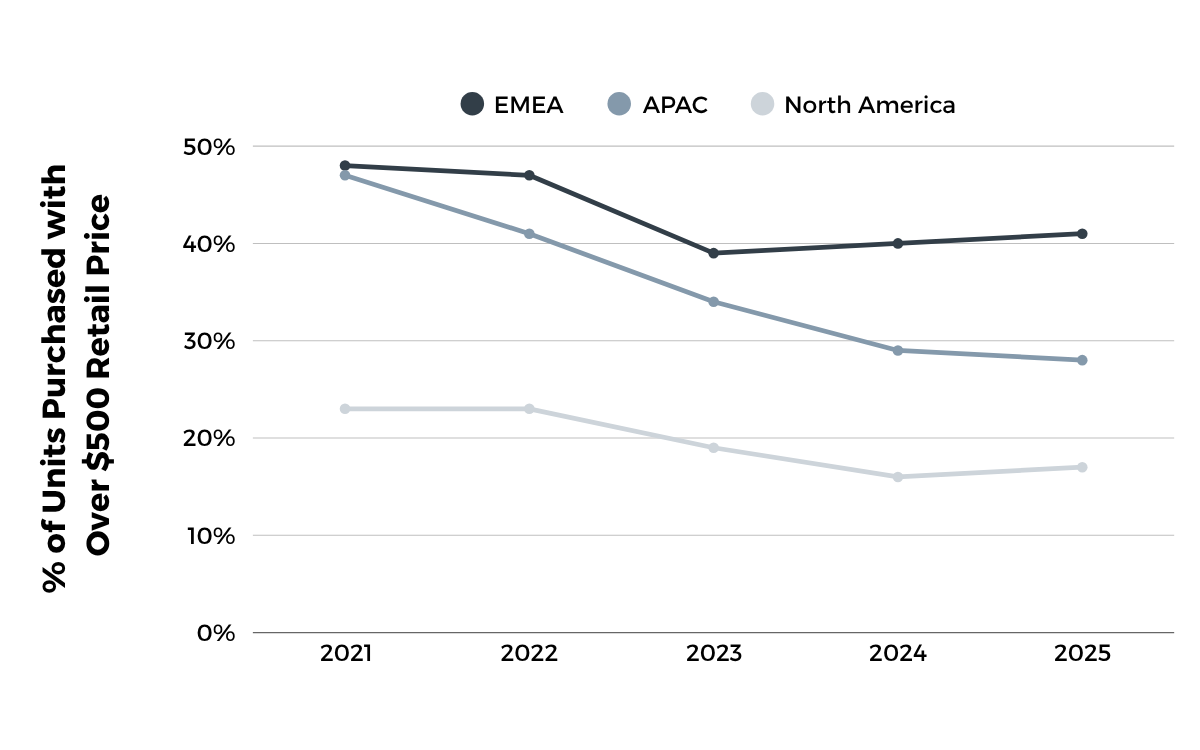
The EMEA region remains the most luxury-oriented footwear market globally, with only 20% of total units purchased by retailers in 2025 falling below the $250 price point, and 41% positioned above $500. This skew toward premium pricing is likely influenced by both production and cultural factors.
Much of the world’s luxury footwear manufacturing is concentrated in EMEA, particularly in Italy and Portugal, where craftsmanship and heritage are revered. As a result, regional consumers may hold a deeper appreciation for artisanal quality, while international shoppers are drawn to making luxury purchases while travelling with the advantage of tax-free purchasing.
The over $1K footwear category has remained consistent at about 5% of retailers’ footwear purchases in EMEA—slightly above the global average which has remained steady at 4% of the footwear market.
It appears that consumers shopping in this ultra luxury price point tend to be more resilient to economic changes, and their spending habits currently appear to be unchanged when it comes to footwear.
The Key Takeaway for Brands
To find new stockists in the European market, browse our “Step Into Style: The World’s Top Footwear Retailers” Passport show. You can filter by region to find new specialist shoe boutiques that could be the perfect match for your product.
The Key Takeaway for Retailers
Our network includes some of the most sought-after luxury footwear brands in the world. Use our Find New Brands directory to start making connections today.
In Conclusion
Whether you are a footwear brand looking to accelerate growth or a retailer wanting to stock the right footwear styles for your consumers’ preferences, use these insights to help propel your business growth next season.
The JOOR platform can help retailers connect with the very best footwear brands from around the world and can also support shoe brands looking to drive more sales. Request your demo today!

Discover the Top 5 Trends in Wholesale for 2025
Related Insights

Top 5 Trends in Wholesale for 2025
Uncover the industry shifts, buying patterns and brand behaviors we predict will shape the wholesale landscape in 2025 and use this forecast to help future-proof your retail business. Explore all of this in our free to download Wholesale Trends 2025 whitepaper.

Italian Market Analysis: Insights to Prepare You for Next Season
Explore the growing demand in the Italian fashion market with findings from JOOR’s exclusive transaction data, and discover how you can use these insights to inform your wholesale growth strategy for the coming seasons.

2025 Fashion Trend Report
Uncover the must-know fashion trends due to be released throughout 2025 with JOOR's exclusive Fashion Trend Report. With appearances from Men's & Women's Spring 2025, Resort 2025, and Fall//Winter, dive into each seasons styles and shop the collections on JOOR Passport - where runway inspiration meets wholesale buying.


.avif)